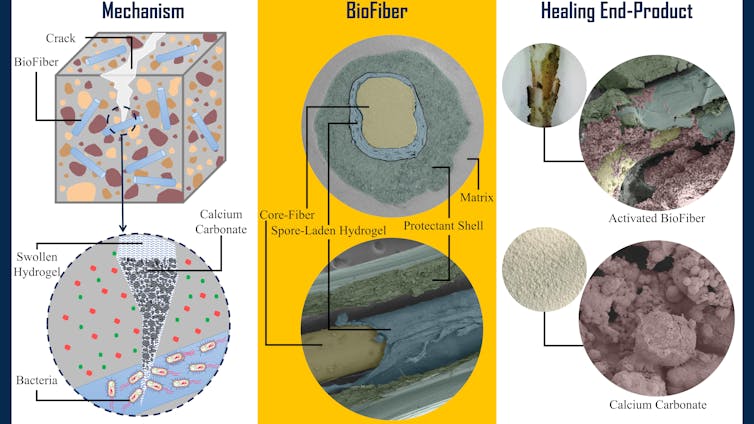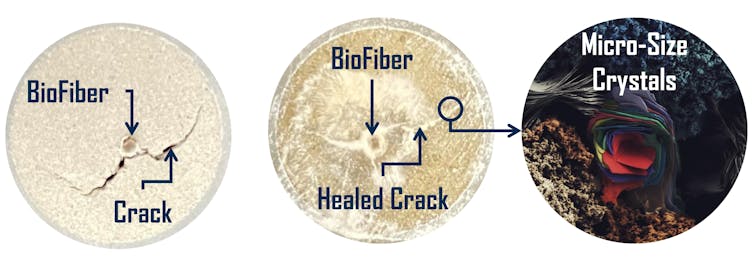

Thin, bacteria-coated fibers could lead to self-healing concrete
source link: https://theconversation.com/thin-bacteria-coated-fibers-could-lead-to-self-healing-concrete-that-fills-in-its-own-cracks-220190
Go to the source link to view the article. You can view the picture content, updated content and better typesetting reading experience. If the link is broken, please click the button below to view the snapshot at that time.
Thin, bacteria-coated fibers could lead to self-healing concrete that fills in its own cracks
Thin, bacteria-coated fibers could lead to self-healing concrete that fills in its own cracks
Authors
Disclosure statement
Mohammad Houshmand works for Drexel University. He receives funding from the National Science Foundation.
Yaghoob Farnam receives funding from the National Science Foundation. In addition to his role as an associate professor at Drexel University, he is co-founder and senior technical advisor for SusMaX Inc.
Partners
Drexel University provides funding as a member of The Conversation US.
Republish our articles for free, online or in print, under Creative Commons licence.
Some say there are two types of concrete – cracked and on the brink of cracking. But what if when concrete cracked, it could heal itself?
We’re part of a team of materials scientists and microbiologists that has harnessed the power of bacteria to create biological fibers that initial results suggest can heal cracks in concrete. We’re working on a technology that, if we work out the kinks and manage to bring it to the market one day, could extend the life span of concrete.
Cracking concrete
Picture a bridge exposed to snow, rain, temperature changes and trucks carrying heavy loads. The concrete on the bridge will gradually develop cracks from stress and wear. Over time, these cracks expand, allowing water and corrosive substances that weaken the concrete to penetrate further down.
At some point, local authorities have to pay for repairs, which are not only expensive but also disrupt traffic and drain public resources.
Now, consider a medical patient recovering from a severe injury. As the patient’s cells recognize the damage, they release tiny healing agents – like microscopic repair crews. These agents target the wounded area, mending tissues and restoring the cells’ functionality. What if concrete had the same kind of self-healing ability as human tissue?
A self-healing concrete
Our team at the Advanced Infrastructure Materials lab at Drexel University was inspired by self-healing tissue in the human body. We developed an addition to concrete we call BioFiber.
BioFiber has three essential functions: It heals itself on its own, it stops cracks from growing wider, and it remains intact inside the concrete when there aren’t any cracks.
BioFiber’s mechanism and structure. Mohammad Houshmand via Elsevier
Each BioFiber has three key components: a tough core fiber made of a polymer called polyvinyl alcohol, a porous layer of hydrogel infused with Lysinibacillus sphaericus bacteria, and a damage-responsive outer shell. When cracks hit the BioFiber, its outer shell breaks and releases the bacteria into the crack, which starts the self-healing process.
The strong core fibers in BioFiber bridge the cracks and stop them from growing wider during the healing process.
Surrounding the core fiber, the hydrogel layer is made up of a mesh of polymer chains at the molecular level that attract water. Their spongelike structure can absorb and hold large volumes of water. During the production process, we add calcium to help the hydrogel solidify.
The hydrogel itself is made up of a natural polymer found in seaweed called alginate, which has special properties that allow it to trap bacteria. Alginate isn’t toxic and is even safe for biomedical applications such as drug delivery and tissue engineering.
The hydrogel houses endospores, which are dormant bacteria. Once the outer shell cracks and the endospores are awakened from their dormant state, they facilitate the self-healing.
Activating BioFiber
The endospores need water to activate. Luckily, the middle hydrogel layer absorbs water well. When the concrete cracks, and water from rain, humidity or street runoff seeps in, the spores wake up.
The spores ingest carbon that we specifically add into the concrete mix, as well as calcium in the concrete itself. With these materials, the bacteria facilitates a chemical reaction called microbially induced calcium carbonate precipitation, or MICCP. This reaction creates calcium carbonate crystals, which build up and fill in the cracks in the concrete.
The crystal shape varies, from sphere to needle-shaped, and each shape is strong enough to heal the cracks. We can alter the type of crystals the bacteria produces by changing the pH level, calcium source and type of bacteria.
BioFiber healing a crack with calcium carbonate crystals. Mohammad Houshmand via Elsevier
Concrete acts like a solid, tough substance because it’s a mix of cement, sand, gravel and water. We toss the BioFibers into the mix and spread them out as the concrete is mixed, ensuring they’re evenly distributed throughout the mixture.
Once the self-healing process ends and the bacteria dies, the activated BioFiber is done – it can’t heal anymore. But since the concrete has many BioFibers distributed throughout, another fiber can mend the next crack. At the moment, we do not know how many cracks BioFiber concrete can heal, and we’re conducing more research to figure that out.
To feed the bacteria, we add the amount of food it needs to stay alive and heal the cracks, depending on how many cracks we anticipate them having to fix. When the bacteria runs out of food, the process stops. The bacteria can live for roughly a couple of weeks during the healing process.
While BioFiber shows initial promise, it does have shortcomings, which could make manufacturing it at a larger scale challenging. The manufacturing process and materials used are specialized and not always affordable and practical. While our first tests suggest that BioFiber extends the life span of concrete, we’ll need more testing, including field trials, to verify those early results.
We hope to eventually commercialize and manufacture the fibers at larger production scales, while in the meantime we continue to run tests and study how to improve BioFiber’s self-healing abilities. We’d like to one day get these fibers into roads and sidewalks to potentially prevent cracking in aging concrete.
Recommend
About Joyk
Aggregate valuable and interesting links.
Joyk means Joy of geeK

